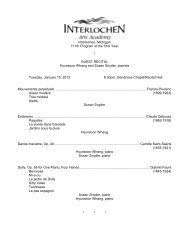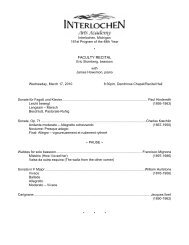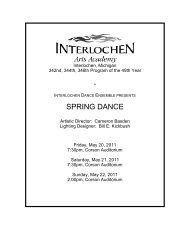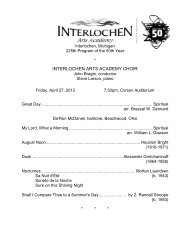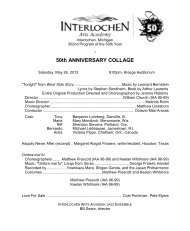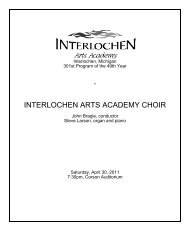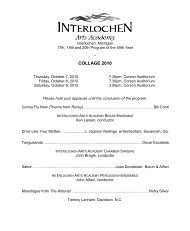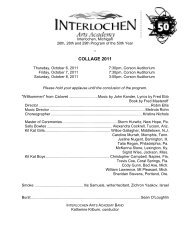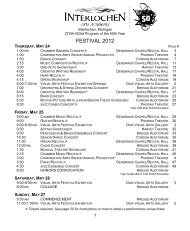13 Band 10-1.pdf - Arts Academy High School
13 Band 10-1.pdf - Arts Academy High School
13 Band 10-1.pdf - Arts Academy High School
Create successful ePaper yourself
Turn your PDF publications into a flip-book with our unique Google optimized e-Paper software.
Satirical and at times downright grotesque, these marches demonstrate Krenek's life-long<br />
dislike of the military. Although traditional march rhythms and forms are employed, Krenek<br />
seems interested in mocking the repertoire of the military bands by incorporating nonmilitary<br />
elements.<br />
Symphony No. 2 (2004) Frank Ticheli<br />
The symphony’s three movements refer to celestial light – Shooting Stars, the Moon, and<br />
the Sun. Although the title for the first movement, "Shooting Stars," came after its<br />
completion, I was imagining such quick flashes of color throughout the creative process.<br />
White-note clusters are sprinkled everywhere, like streaks of bright light. <strong>High</strong> above, the<br />
E-flat clarinet shouts out the main theme, while underneath, the low brasses punch out<br />
staccatissimo chords that intensify the dance-like energy. Fleeting events of many kinds<br />
are cut and pasted at unexpected moments, keeping the ear on its toes. The movement<br />
burns quickly, and ends explosively, scarcely leaving a trail.<br />
The second movement, "Dreams Under a New Moon," depicts a kind of journey of the soul<br />
as represented by a series of dreams. A bluesy clarinet melody is answered by a chantlike<br />
theme in muted trumpet and piccolo. Many dream episodes follow, ranging from the<br />
mysterious, to the dark, to the peaceful and healing. A sense of hope begins to assert itself<br />
as rising lines are passed from one instrument to another. Modulation after modulation<br />
occurs as the music lifts and searches for resolution. Near the end, the main theme returns<br />
in counterpoint with the chant, building to a majestic climax, then falling to a peaceful coda.<br />
The final B-flat major chord is colored by a questioning G-flat.<br />
The finale, "Apollo Unleashed," is perhaps the most wide-ranging movement of the<br />
symphony, and certainly the most difficult to convey in words. On the one hand, the image<br />
of Apollo, the powerful ancient god of the sun, inspired not only the movement's title, but<br />
also its blazing energy. Bright sonorities, fast tempos, and galloping rhythms combine to<br />
give a sense of urgency that one often expects from a symphonic finale. On the other<br />
hand, its boisterous nature is also tempered and enriched by another, more sublime force,<br />
Bach's Chorale BWV 433 (Wer Gott vertraut, hat wohl gebaut). This chorale--a favorite of<br />
the dedicatee, and one he himself arranged for chorus and band--serves as a kind of<br />
spiritual anchor, giving a soul to the gregarious foreground events. The chorale is in<br />
ternary form (ABA'). In the first half of the movement, the chorale's A and B sections are<br />
stated nobly underneath faster paced music, while the final A section is saved for the<br />
climactic ending, sounding against a flurry of sixteenth-notes.<br />
~Program note by Frank Ticheli<br />
* * *<br />
In consideration of the performing artists and other patrons, the use of flash photography is not permitted.<br />
Federal copyright and licensing rules prohibit the use of video cameras and other recording equipment.<br />
In order to provide a safe and healthy environment, Interlochen maintains a smoke-free and alcohol-free campus.<br />
Michigan law prohibits any weapons, including concealed weapons, on Interlochen property<br />
because we are an educational campus. Thank you for your cooperation.<br />
www.interlochen.org







